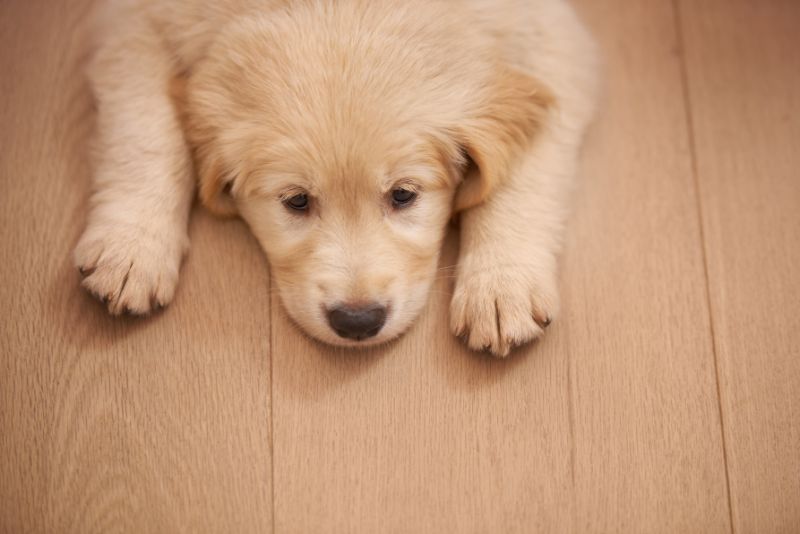Coming Through With Flying Colors: House Training A Puppy

When you bring a new puppy into your home, you can count on a few accidents… to say the least. This is just one aspect of the joys of being a new puppy owner. But house training a puppy doesn’t have to be difficult, or take forever. There are several effective and positive ways to get you and your pup successfully through the process.
Remember that whatever method you choose, stick with it and be consistent. Keep reading for some tips from the Dupont Veterinary Clinic.
Common Ground
Dogs innately want to keep their personal living area clean. They will venture away from their own territory to use the bathroom. But it’s important not to give a new puppy too much space too soon.
Every pet is an individual, a fact that you know well if you already have pets. Each pup will pick up on the concept of house training at his own pace. So patience in this process is key.
Punishing your pup for eliminating it in the house is never a good idea. Pets don’t have the higher reasoning capability to know that peeing in the house is wrong. Punishment and harsh words will confuse and scare her – which will only make house training take even longer.
A Safe Space
Crates work very well for helping a puppy learn to wait to go outside to the bathroom. You can use a small crate that is only big enough for your puppy to turn around, stand, and lie down in. you could also keep your puppy right by your side clipped to a four to six foot leash.
The 15 Minute Rule
You can get way ahead of house training a puppy with the knowledge that most puppies need to use the bathroom within 15 minutes of waking up, eating, drinking, or playing. So each time your puppy does one of these activities, take him or her outside to her designated bathroom spot within 15 minutes.
Praise, Praise Praise
When it’s time for a potty break, take your puppy outside to the designated bathroom spot and wait 5 minutes. Once your puppy does her business in the right spot, praise her with lots of wonderful pets and words. She’ll quickly learn that going to the bathroom outside brings good things.
Then, don’t take her right back to her crate – which could be interpreted as punishment for going to the bathroom. Keep her out for a 10-15 minute playtime with you or in a supervised larger area, and then return her to her crate.
If your puppy does not eliminate within the 5 minutes, return her to the crate calmly and try again for a potty break in another 15 minutes.
Timing Is Everything
A good rule of thumb is that a puppy can hold her bladder one hour for each month of her age, plus one. So a two month old puppy can hold it for up to three hours. But each dog is an individual and it’s best not to push your puppy’s limit.
If you can watch your puppy like a hawk, you can take her out when she sniffs or begins to circle. If you’re not home, however, you need to think about who and how she can be taken out to her bathroom spot on a very regular basis.
Accidents happen, so if you catch your puppy eliminating it in the wrong spot, you can calmly interrupt her with an “oops’ ‘, and take her immediately to the right spot.
Use enzymatic cleaners on accidents, to discourage your pet from smelling his scent and going to the bathroom there more often.
Introduce More Space Gradually
Once your puppy is successfully going to the bathroom outside, and keeping her crate space unsoiled, you can let gradually open up one room at a time to her. If she continues to be accident free, she can soon have the run of the house. If accidents start happening, just confine her to the area that was last successful. Keep to a regular schedule of bathroom breaks and reward for proper elimination throughout the entire process.
Getting Up At Night
Having a new puppy is a bit like having a new baby; you’re going to have to get up at night.
You may need to take your puppy out multiple times a night. It’s important not to push your puppy to hold her bladder past the time she physically can. If she has to sleep in her own urine and feces, she’ll learn to be more comfortable with it, and that can make house training even more difficult.
Potty Pads Not Recommended
Most dog trainers and behaviorists do not recommend using pee pads as a house training aid. Although it may be convenient, especially during inclement weather, it tends to confuse dogs and lead to more accidents when they are allowed to urinate on pee pads as puppies but not as adults.
House training a puppy takes patience and perseverance. But with positive reward, encouragement, and consistency, it may not be as difficult as it seems. If you have questions or concerns about house training, please don’t hesitate to reach out to our team.
